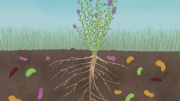Scientists from Indiana University have shown that a rare tropical plant absorbs the genes of other plant species. Amborella trichopoda, a shrub found on the island of New Caledonia 750 miles from the coast of Australia, carries the complete mitochondrial genomes of three species of algae, one moss species, and the genomic fragments of other species of flowering plants.
As the only survivor from one of the two oldest lineages of flowering plants, A. trichopoda has had ample time to acquire these changes to its mitochondrial genome. One of the ways mitochondria undergo these changes is through a process known as mitochondrial fusion, in which two mitochondria merge within one cell.
“We found the first evidence that mitochondria of flowering plants and green algae, whose last common ancestor existed over a billion years ago, undergo fusion by the same mechanism,” said Danny Rice, one of the lead scientists on the project.
Mitochondrial fusion is instrumental in a process called Horizontal Gene Transfer (HGT). In HGT, DNA from one organism is able to enter and be incorporated into another organism. Horizontal Gene Transfer is an important evolutionary force in organisms such as bacteria, Archaea, and unicellular eukaryotic organisms such as protozoa, amoeba, or plankton.
There has been little evidence of HGT functioning as a genetic mechanism in multicellular eukaryotic organisms like fungi, plants, and animals. With this new information collected on A. trichopoda, it is evident that HGT in plants is not only possible, but recent and widespread.
In fact, A. trichopoda is the largest example of HGT in any known organism. Furthermore, it is the first time in which scientists see an example of an organelle genome absorbing a complete foreign genome. It is also the first time that a land plant has been shown to acquire genes from an aquatic species of plant, like the green algae.
This work on A. trichopoda gives scientists insight into the mechanisms of HGT. In this case, it occurs by direct physical contact. A whole mitochondrion is captured by A. trichopoda when the cells of both the host and parasite plants come into contact. The mitochondria then fuse, and the genes within them are recombined so that all of the genes fit into the single host mitochondrion. In this way, A. trichopoda has acquired entire mitochondrial genomes from algae and moss species.
Jeff Palmer, another one of the lead scientists on the study, explains that this research provides “compelling evidence that mitochondrial fusion is the driving force for mitochondrial gene transfer.”
Further research involving Amborella will help illuminate the ancestral states of important genes in flowering plants.



